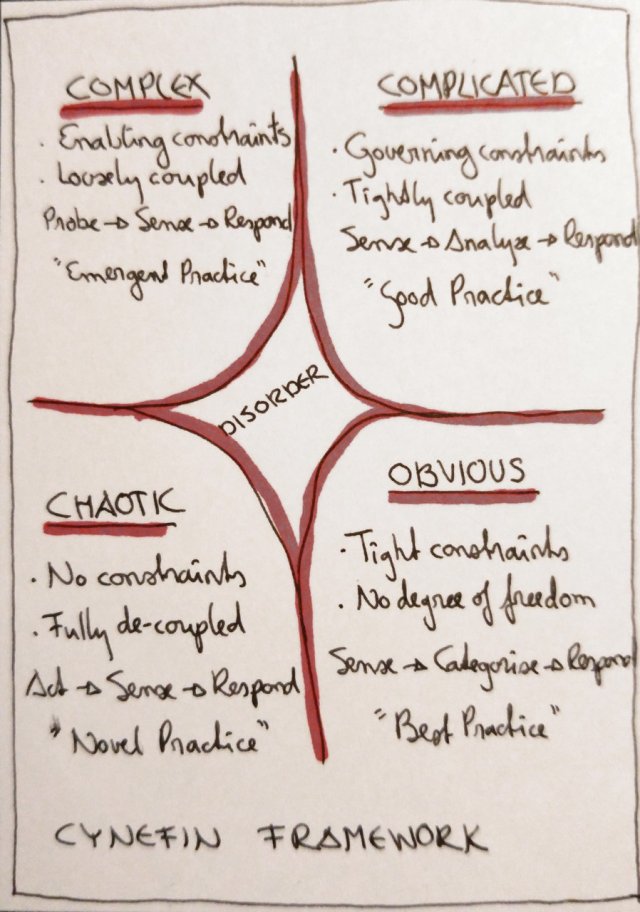If you don’t know the Why, don’t try and scale a How.

Notes from a presentation by Dave Snowden: Embrace Complexity, Scale Agility
Sense making: How do we make sense of the world so that we can act in it? And given that you can never know everything you need to know: how do you know when you know enough and what kind of actions can you take based on what you do know?
“All paths up are different. All paths down are the same” - @gapingvoid
Meaning: there is no recipe for success. There is a recipe for failure: repeat past mistakes. Reduce the rate of failure by learning earlier in the process through interacting with users.
Cynefin framework
A sensemaking framework for finding out which kind of approach to use for finding possible solutions in different contexts. The framework has five domains: Ordered, Complicated, Chaotic, Complex and Disorder.
Snowden has a fun routine explaining the difference between Ordered, Complex and Chaotic using the analogy of a children’s party. (This links to a recording of a different but similar talk, check it out).
Ordered
A highly constrained environment without freedom of movement. The relationship between cause and effect is obvious to all. The approach is to Sense -> Categorise -> Respond and we can apply best practice. Highly ritualised way of working, e.g. checklists. The problem is understood, the steps to solve it are known and fixed as well.
Complicated
Where the relationship between cause and effect is not immediately obvious. The situation has to be analyzed with expert knowledge to find out what to do. The approach is to Sense -> Analyze -> Respond and good practice can be applied.
Chaotic
No constraints at all, everything operates independently from everything else. No relationship between cause and effect. The approach is to Act -> Sense -> Respond, and you can discover novel practice. This is a transitionary state because it requires huge amounts of energy to not have constraints.
Complex
A.k.a. daily reality. There are constraints, but these enable and modify behaviour in the system, and the behaviour then modifies the constraints. The approach is to Probe -> Sense -> Respond so that you can discover emergent practice.
Disorder
The fifth domain of disorder is the state wherein you don’t know in which of the above four domains you are.
Complexity is daily reality
A complex system is not causal. Complex systems have propensities (inclination or tendencies to behave in a certain way) and dispositions (an inherent temperament, character), but there is no linear cause and effect.
Complexity can be managed, but only as a flow, not as a static system.
Managing flow in complex systems means you manage the emergence of beneficial coherence within attractors within boundaries. What you’re looking to design is a working boundary that, with the right attractors, produces desired behaviours and outcomes.
Whew! My oversimplified version of what that means: amplify what works well and dampen the negative effects. You can not expect predefined results. You have to manage the evolutionary potential of the present moment in time and adjust as you go. Again: check out the children’s party analogy.
Solving problems in a complex world means focussing on running multiple smaller experiments that are safe to fail instead of working towards one fail-safe design. Smaller experiments, faster, in parallel. (This is why Scrum is not a true complexity technique because it does one thing in a linear way)
Through the experiments (prototypes of newly designed constraints?) you move from the center of complexity towards the boundary with the complicated domain. Once the new constraint is replicable and produces repeatable behaviour, you have moved it from the complex to the complicated domain and you can start to scale it.
If it does not produce repeatable behaviour, you move back into complexity and initiate more (different!) experiments. The trick is getting the cadence right of moving things from complex (unpredictable) to complicated (mostly predictable) and back to complex where necessary.
A bit of cognitive science
- Fact: you only scan 3 to 5% of what’s in front of you. You match that input against previous patterns (from recent memories) and make decisions based on that.
- Fact: after 3 interviews you start to form a subconscious hypothesis and then only pay attention to the things that match it. So you can’t really trust the analyst (or design researcher) to really understand what users need. And users don’t know what they need either.
Scalable ethnography using human metadata
- Reduce granularity
- Distribute cognition
- Disintermediate decision makers
If you don’t know the Why, don’t try and scale a How.
- Micro narratives or observations are the basic unit of sense making
- Meaning does not reside in text. It is provided by human actors, in context
- Abstraction is the key to interpretation and reuse
- Description opens up more possibilities than evaluation
- “More like these, less like those”
- Navigate landscapes
Manage vector, not velocity.
- Complexity does not scale by aggregation
- Reduce granularity, distribute cognition, radical recombination
- Scale by finding new patterns across the whole domain
- Engage the real C-level & ecosystem
- Learn early, fail less.